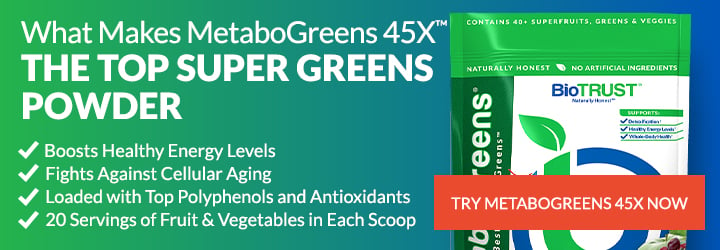4 Toxic Ingredients That Are Hiding in Your Food

ANY chemical—synthetic or natural—can be toxic if you eat, drink, or absorb too much of it. Even water can be lethal if you drink too much too quickly. As the notable Swiss physician and alchemist Paracelsus wrote, “All substances are poisons; there is none which is not a poison. The right dose differentiates a poison from a remedy.”
It is true the dose makes the poison, and even healthy ingredients may have negative effects. Yet the following toxins in food are among the most crucial to keep an eye out for. As even small amounts can be toxic.
4 Scary Toxins in Food
Trans Fats
Food manufacturers have been notorious for adding partially hydrogenated vegetable oils to processed foods. Why? Because they’re super-cheap, help improve shelf-life, and enhance how foods taste (by manipulating mouthfeel, texture, overall tastiness, etc.). They’re what make peanut butter smooth and creamy with no stirring required. Unfortunately, they’re also the primary dietary source of industrial-produced trans fats.
A recent ruling by the United States Food and Drug Administration (FDA) determined partially hydrogenated oils are not safe for human consumption. As such, the FDA will no longer allow food manufacturers to include them in processed foods.
This is great news! But there’s a catch. Food manufacturers have until June 18, 2018, to ensure their products no longer contain partially hydrogenated oils. In the meantime, you still need to read both the Nutrition Facts Panel and the ingredients list. Because while food manufacturers are required to list the amount of trans fats per serving, if the amount is below 0.5 grams per serving, companies can label the product as containing ZERO.
In essence, industrial-produced trans fats are like tobacco. They’re not beneficial at any dose! Evidence indicates any intake of trans fats will increase your risk for cardiovascular disease. Trans fats have also been linked to several other negative health outcomes. This includes obesity (preferentially, excess belly fat), unhealthy levels of inflammation, and decreased insulin sensitivity.
Simply put, because trans fats are detrimental to health at ANY level, yet can be “hidden” in virtually any type of processed food, it’s imperative to read the ingredients list. If you see “partially hydrogenated vegetable oil” listed, please step away from the health bomb.
Heavy Metals
Certain heavy metals (such as zinc, copper, nickel, cobalt, and chromium) are vital for health. Non-essential heavy metals, on the other hand, serve no biological purpose. Even worse, they can be very toxic. The heavy metals of greatest concern include lead, mercury, arsenic, and cadmium.
–Lead is toxic at the lowest concentrations. It’s associated with blood-related disorders; high blood pressure; kidney, joint, reproductive, and cardiovascular systems disorders; loss of IQ, as well as others.
According to the European Food Safety Authority, bread and rolls, tea, tap water, potatoes and potato products, fermented milk, and beer are the most likely suspects.
To limit lead intake, it’s a good idea to invest in a good water filter/filtration system that removes lead.
–Mercury is another highly toxic heavy metal that poses serious health risks. The most common food source of mercury is seafood, which contains a specific form called methylmercury. This is a neurotoxin that causes brain and nervous system damage and is also toxic to the kidneys, liver, and heart.
It also explains why pregnant and nursing women should be very strict about limiting fish consumption and choose only low-mercury sources of seafood. Mercury can pass from mom’s body and breast milk to developing fetuses and infants where it can have devastating effects on their growing brains and nervous systems. Exposure can negatively impact a child’s cognitive thinking, memory, attention, language, and fine motor as well as visual special skills.
I don’t know about you, but that list gives me chills. What’s more, methylmercury affects people of ALL ages. It can attack your brain, nervous system, and kidneys the same way it does a child’s.
While there’s no such thing as a mercury-free fish, some fish contain substantially more. For instance, long-lived predators—like swordfish, shark, orange roughy, and tuna—tend to have the highest levels of mercury.
-Rice is often thought of as the most common food containing arsenic. Yet wheat-based processed products (e.g., wheat bread, rolls) tend to be the main contributor according to the European Food Safety Authority. Rice, milk, and drinking water are other significant contributors. Arsenic is associated with all sorts of issues you want to avoid, including vascular disease; lung, skin, kidney, and bladder cancers; disturbances of the cardiovascular and central nervous systems, which may lead to death; and bone marrow depression for the short list.
-In general, high concentrations of cadmium, one of the most toxic heavy metals, are found in algae, cocoa-based products, crustacean shellfish, seaweeds, and oilseeds (e.g., vegetable and seed oils).
That being said, the foods that tend to contribute the most cadmium are potatoes, bread and rolls, baked goods, chocolate products, leafy vegetables, and water mollusks (e.g., snails, oysters). Cadmium is associated with bronchial and pulmonary irritation, kidney stones, and liver damage.
Pesticides and Herbicides
If you’re looking to stir things up at your next social gathering, bring up one of the following topics: Politics or GMOs. One of the more highly debated topics in health and nutrition surrounds genetically modified (GM) foods, or genetically modified organisms (GMOs), which are plants or animals created through genetic engineering.
One of the most important concerns is that 80% of all GMOs grown worldwide are engineered to tolerate the toxic herbicide glyphosate. (You may know it better as “Roundup.”) Since 1970 when it was first brought to market, its use has increased 100-fold! Ironically, one of the proposed benefits of GMOs was that they were supposed to result in less use of toxic herbicides. Not so much.
Glyphosate-based herbicides are used on a wide range of GM crops (corn, soybeans, canola, wheat, barley, etc.). Testing by the UK-Food Standard Agency and USDA has revealed glyphosate residues in up to 90% of the samples of these crops. Because of its rampant agriculture use, researchers have even found residues in the air we breathe and the water we drink.
Here’s why this is concerning: Glyphosate is authoritatively classified as a probable human carcinogen. It may also be linked to Alzheimer’s disease, depression, Parkinson’s, autism, and others. One group of researchers reported glyphosate’s “negative impact on the body is insidious and manifests slowly over time as inflammation damages cellular systems throughout the body.” Sounds pretty scary…and it is!
To limit your exposure, I have two suggestions: 1. Choose organic foods when possible; and 2. Avoid processed foods.
Artificial Additives
Artificial sweeteners, such as sucralose, saccharin, aspartame, and acesulfame-K, are often added to processed foods to boost flavor without adding calories. While the rationale seems health-conscious (reducing calorie intake, helping manage blood sugar levels), emerging evidence suggests the costs may drastically outweigh any potential benefits. Artificial sweeteners have been tied to:
- Gut dysbiosis (i.e., the increase of bad bacteria)
- Poor carbohydrate tolerance
- Increased hunger
- Weight gain
- Oxidative stress
- Accelerated aging
- Cognitive decline
Meanwhile, the artificial flavor enhancer monosodium glutamate (i.e., MSG) can cause adverse reactions (e.g., headaches) in folks who are MSG-sensitive. It may also be linked to weight gain. Yippee. Weight gain and headaches. How fun. While the connection is not entirely clear, it’s possible MSG leads to excess caloric intake by increasing palatability and damaging the brain’s ability to regulate appetite. Additionally, MSG may lead to decreased sensitivity to the satiety hormone leptin, which is closely connected with weight gain and obesity.
Unfortunately, most manufacturers do not openly disclose that a product contains MSG. And it’s not always as simple as looking for MSG on the label. Here are some common ingredients that may be “hidden” sources of MSG:
- Hydrolyzed vegetable protein (e.g., hydrolyzed soy protein)
- Natural flavors (a proprietary blend of ingredients that can include MSG)
- Seasonings (like natural flavors, a proprietary blend of ingredients that may include MSG)
- Maltodextrin
- Yeast extract
Another artificial preservative worth mentioning is parabens, which have been around since the 1920s. They’re commonly used in foods, industrial products, cosmetics, and personal care products for their antimicrobial properties. By preventing the growth of bacteria, they can extend shelf-life. Unfortunately, they can also mimic estrogen and disrupt how the body metabolizes estrogen. They’re associated with numerous health risks, including a variety of chronic diseases and cancers as well as a host of developmental disorders and fertility issues.
In addition, parabens inhibit mitochondrial function. The mitochondria are often described as the “powerhouses” of cells, as they are responsible for creating energy from the food we eat and store.
Parabens are present in a wide variety of cosmetics and personal care products, including lotions and moisturizers, skin and hair cleansers, sunscreens, deodorants and antiperspirants, toothpastes, makeup, and many others. They are also used as preservatives in food and beverages. You can avoid parabens by reading ingredient labels. The five most common to watch for are methyl-, ethyl-, propyl-, isopropyl-, and butylparaben.
The Dose Makes the Poison
Where will you find most, if not all, these potentially toxic ingredients? That’s right: processed foods. The unfortunate (and shocking) reality is that these very foods make up more than 70% of the typical diet. Simply shifting to eating more whole, minimally processed foods can go a long way to avoiding toxins in food. So while the effects of these toxins are downright scary, it’s actually pretty easy to reduce your exposure.







